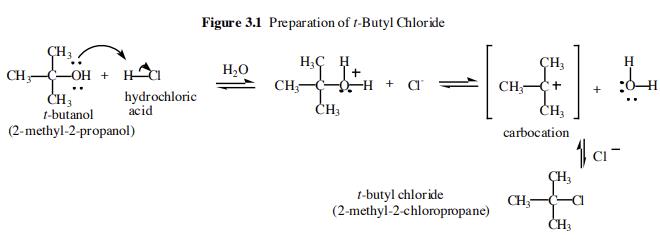| Identification | More | [Name]
2-Chloro-2-methylpropane | [CAS]
507-20-0 | [Synonyms]
2-CHLORO-2-METHYLPROPANE
2-CHLORO-ISO-BUTANE
2-METHYL-2-CHLOROPROPANE
AKOS BBS-00004388
T-BUTYL CHLORIDE
TERT-BUTYL CHLORIDE
Trimethylchloromethane
1-Chloro-1,1-dimethylethane
2-Chlor-2-methylpropan
2-chloro-2-methyl-propan
2-Methyl-2-propyl chloride
2-methyl-2-propylchloride
Chlorotrimethylmethane
Propane,2-chloro-2-methyl-
tert.-Butylchlorid
tert-Butylchlorid
tert-C4H9Cl
Tertiary-butyl chloride
2-Chloro-Tertbutane
2-Chloro-2-methylpropane, 98+% | [EINECS(EC#)]
208-066-4 | [Molecular Formula]
C4H9Cl | [MDL Number]
MFCD00000816 | [Molecular Weight]
92.57 | [MOL File]
507-20-0.mol |
| Chemical Properties | Back Directory | [Appearance]
colourless liquid | [Melting point ]
-25 °C (lit.) | [Boiling point ]
51-52 °C (lit.) | [density ]
0.851 g/mL at 25 °C(lit.)
| [vapor density ]
3.2 (vs air)
| [vapor pressure ]
4.82 psi ( 20 °C)
| [refractive index ]
n20/D 1.385(lit.)
| [Fp ]
−10 °F
| [storage temp. ]
Flammables area | [solubility ]
soluble in Chloroform | [form ]
Liquid | [color ]
Clear | [Stability:]
Stable. Extremely flammable. Note low flash point. Incompatible with strong oxidizing agents. Vapour, being much denser than air, may travel considerable distances to a source of ignition. Hygroscopic. | [explosive limit]
1.8-10.1%(V) | [Water Solubility ]
SLIGHTLY SOLUBLE | [Merck ]
14,1562 | [BRN ]
1730872 | [Dielectric constant]
10.949999999999999 | [InChIKey]
NBRKLOOSMBRFMH-UHFFFAOYSA-N | [LogP]
2.45 at 20-25℃ | [CAS DataBase Reference]
507-20-0(CAS DataBase Reference) | [NIST Chemistry Reference]
Propane, 2-chloro-2-methyl-(507-20-0) | [EPA Substance Registry System]
507-20-0(EPA Substance) |
| Safety Data | Back Directory | [Hazard Codes ]
F | [Risk Statements ]
R11:Highly Flammable. | [Safety Statements ]
S16:Keep away from sources of ignition-No smoking .
S29:Do not empty into drains .
S33:Take precautionary measures against static discharges .
S7/9:Keep container tightly closed and in a well-ventilated place .
S9:Keep container in a well-ventilated place . | [RIDADR ]
UN 1127 3/PG 2
| [WGK Germany ]
1
| [RTECS ]
TX5040000
| [Autoignition Temperature]
570°C | [TSCA ]
Yes | [HazardClass ]
3 | [PackingGroup ]
II | [HS Code ]
29031980 | [Safety Profile]
Questionable
carcinogen with experimental neoplastigenic
data. Dangerous fire hazard when exposed
to heat, flame (sparks), and oxidlzers. To
fight fue, use water, spray, fog, alcohol
foam, dry chemical. When heated to
decomposition it emits toxic fumes of Cl-.
See also CHLORINATED
HYDROCARBONS, ALIPHATIC. |
| Raw materials And Preparation Products | Back Directory | [Raw materials]
Hydrochloric acid-->tert-Butanol | [Preparation Products]
Pivaloyl chloride-->tert-Butylamine-->Pyridaben-->(R)-(+)-2-Methyl-2-propanesulfinamide-->tert-Butylbenzene-->1,1'-Bis (di-t-butylphosphino)ferrocene palladium dichloride,-->Pivalic acid-->2-DI-TERT-BUTYLPHOSPHINO-2',4',6'-TRIISOPROPYLBIPHENYL-->1,1'-Bis(di-tert-butylphosphino)ferrocene-->(R)-1-[(1S)-2-(DIPHENYLPHOSPHINO)FERROCENYL]ETHYLDI-TERT-BUTYLPHOSPHINE-->Di-tert-butylchlorophosphane-->Tri-tert-butylphosphine-->tert-Butyl nitrite-->Terbinafine-->Tri-tert-butylphosphine tetrafluoroborate-->Diclobutrazol-->Bis(tri-tert-butylphosphine)palladium(0)-->Musk xylene-->4-tert-Butylbenzylamine-->ETHOPERMETHRIN���,95%-->TERT-BUTYLMAGNESIUM CHLORIDE-->2,4,6-Tri-tert-butylphenol-->2,7-DI-TERT-BUTYLNAPHTHALENE-->1-CHLORO-4-PHENYLBUTANE-->2,6-Di-tert-butylnaphthalene-->1,1-DICHLORO-3,3-DIMETHYLBUTANE |
| Hazard Information | Back Directory | [Chemical Properties]
colourless liquid | [Uses]
- 2-Chloro-2-methylpropane is an alkylating agent that is used to functionalize molecules with tert-butyl group.
- It serves as an effective chlorinating agent, in combination with the ionic liquid, 1-butyl-3-methylimidazolium bromide for converting alcohols into chlorides.
- It can also be used to prepare tert-butyl ethers by treating with corresponding alcohols.
| [Application]
tert-Butyl chloride plays an important role as a starting material to perform nucleophilic substitution reactions in order to prepare alcohol and alkoxides salts. It is used as an alkylating agent for the introduction of tert-butyl group and is also involved in Friedel-Crafts reactions. It is employed as an intermediate for the synthesis of agrochemicals and pharmaceuticals. | [Flammability and Explosibility]
Flammable | [Synthesis]
tert-Butyl chloride is prepared from tertbutyl alcohol (tert-butanol) using an acid catalyzed dehydration reaction.

The first step of the overall reaction is an acid-base reaction between the t-butanol and the hydrochloric acid. The t-butanol is a weak base and the hydrochloric acid is a strong acid. The alcoholic oxygen becomes fully protonated and so the equilibrium lies far to the right. In the second step we have the slow loss of water to form a carbocation intermediate. This species is very reactive and is immediately attacked by the chloride ion liberated in the first step to form tert-Butyl chloride. | [Purification Methods]
Purification methods commonly used for other alkyl halides lead to decomposition. Some impurities can be removed by photochlorination with a small amount of chlorine prior to use. The liquid is washed with ice water, dried with CaCl2 or CaCl2 + CaO and fractionally distilled. It has been further purified by repeated fractional crystallisation by partial freezing. [Beilstein 1 IV 288.] |
|
|